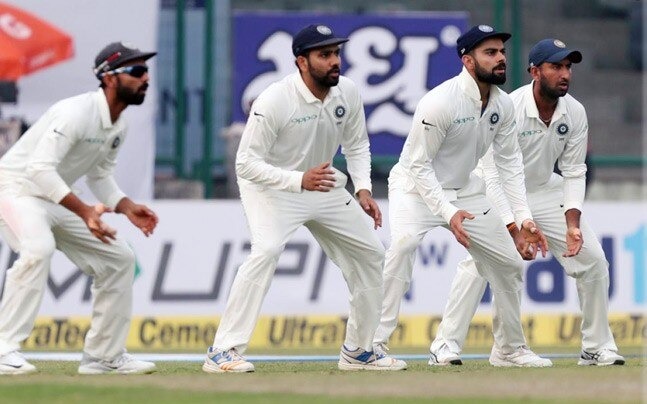
In 2021, at the Ageas Bowl in Southampton, it was New Zealand’s date with destiny as they hoisted the inaugural World Test Championship (WTC) trophy. India, who ended up second-best on that occasion, have since willed themselves to one more WTC final, against Australia, at The Oval.
As Australia and India crank up their preparations, what could be the specific areas that both teams would look to work on? The obvious ones would be for batters and bowlers to adjust to the different conditions. But there is another crucial aspect of the game that would be of prime focus for the two sides, and that is slip fielding. With both teams having some highly-rated pace bowlers in their ranks, you would expect a slew of catches to be taken in the slip cordon, at least on the first two days.
So, what goes on behind the scenes in relation to various slip-fielding drills? Over a period of time, have India improved their slip fielding? R Sridhar, who served as India’s fielding coach for seven long years, and was instrumental in helping the national side improve their slip-catching percentage from the mid-60s to 84 per cent, is perhaps the best man to talk to when it comes to India’s cordon.
Sridhar flags off the discussion on India’s slip cordon by sharing his insights on a couple of the stalwarts of the side: Rohit Sharma and Virat Kohli. One appears to be more laidback and the other more an in-your-face character. One of them is perhaps more of a natural as far as fielding in the slips is concerned, while the other has improved with time.
“Virat and Rohit are two very different kinds of athletes,” he told RevSportz. “Virat is extremely fit and agile, and was always a very good outfielder. In my seven years, I spent a lot of time with Virat the slip catcher. Initially we used his energy in front of the batsman’s eyes, like at short-cover or short-midwicket, because with his intensity he could literally intimidate the batsman. But over time, and this was also because he was a certainty in the team, we wanted him to stand in the slips. Among the other batters, there was a lot of change going on because of injury and form, and Virat was the only certainty. As a result, it made sense to have him in the slips because it made for consistency. He can come down really quick, and has done a lot of work on his concentration and focus.
“Rohit on the other hand is a natural. He has real natural ability as a slip catcher. We called him Sticky Fingers Rohit Sharma in the dressing room. At the same time, he works very hard on his slip catching and takes at least 60-80 catches during each session to improve it,” said Sridhar. “Virat, KL [Rahul], Rohit… they were all outstanding in the slips. Puji [Cheteshwar Pujara] improved a lot, and then we had Ajinkya [Rahane] as a slip fielder for spinners.
“Practices were excellent – the number of catches they took, the attention to small details, how they chose the right time to catch, which end to catch (at practice), so if they have a difficult background, it becomes easier in the match, catching with different balls, different speeds, at different angles.”
While ranking some of the finest slip fielders India has produced, Rahane’s name would be up there with the best. Statistically, too, he has been India’s top-ranked slip fielder since the start of 2010. What does Sridhar make of Rahane, the slip fielder? “Very nice demeanour to be a slip fielder,” he said. “Very calm, very composed, very relaxed, lovely hands and good hand-eye coordination. Basically, his anticipation level has gone to the next level because he has fielded (in the slips) for close to a decade now. So that is something that has really mastered his position. His practices are excellent.”
With the WTC final at The Oval just a few days, the discussion soon veered towards the all-important game. So what could be the salient features of slip fielding in England, especially considering the conditions at The Oval? Would the fielders in the cordon stand slightly further apart or closer?
“I think at The Oval, the first two days would be very crucial,” said Sridhar. “There would be lots of catches that would come to the slips, because the Oval is a wicket that would start juicy and then start flattening out. So, as it flattens out, you could see a lot of bowleds and lbws. But on day 1 and 2, you will see quite a few catches. England is always a challenge, as the ball wobbles a lot. Having said that, the better the concentration, the better the fielders would catch.
“With the new ball, it is okay to be a little closer [to each other]. But as the ball gets older, maybe you want to space out. It also depends on the fielders’ skills, how comfortable they are in terms of distance between each other. How much understanding do they have? This is a very settled slip cordon. So they will find the exact balance between depth and space.”
Historically, the Oval is not known as an easy ground for slip fielders to pouch catches. Is there any credence to that theory? Sridhar has this to say about the difficulty that a slip fielder could face at the ground: “Sometimes, due to the weather, if it isn’t too bright, it could be a difficult viewing ground, from one end (Vauxhall End) at least.”
Over the last few years, India seem to have found slip fielders generously bestowed with natural gifts. A few others have made incremental improvements. On paper, India have a settled slip cordon, and they would expect to take their catches in the big game. As one of cricket’s oldest adages tells us: “Catches win matches.”



